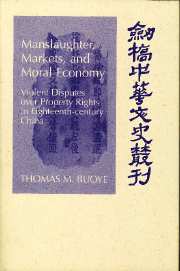 Manslaughter, Markets, and Moral Economy
Manslaughter, Markets, and Moral Economy Published online by Cambridge University Press: 28 October 2009
Since the normalization of diplomatic relations between China and the United States in the 1980s, American scholars have gradually gained access to a wide range of primary source materials that have enriched the quality and extended the scope of historical research on China. Throughout the 1950s and 1960s, the limited access to primary sources stifled the field of Chinese social and economic history in the United States. Except for the works of several Chinese-born scholars, such as Ho Ping-ti, who produced the classic work on demographic history; Chang Chung-li, whose work on the gentry class remains standard reading; and Hsiao Kung-ch'uan, who wrote a comprehensive guide to rural society, most of the research done in English focused on foreign trade, the treaty ports, or early efforts at industrialization. Conceptually, models derived from European economic history weighed heavily on the scholarship of this period and this produced some rather odd attempts to cast Chinese history in terms of the supposed normative stages of Western development. Generally, the economic stagnation of pre–Opium War China was taken for granted, and comparisons of Western development with Eastern stagnation were frequent. Ironically, the Marxist approach of Chinese and Japanese scholars prevalent at that time, although meant to challenge mainstream Western scholarship, also contributed to establishing the paradigm of Western progress, the Industrial Revolution, as the yardstick for measuring historical development.
After the establishment of the People's Republic of China in 1949, historical research in China was entirely recast in terms of the normative stages of Marxist historical development. Two popular topics in post- 1949 Chinese historiography were studies of peasant uprisings and the identification of the “sprouts of capitalism.”
To save this book to your Kindle, first ensure [email protected] is added to your Approved Personal Document E-mail List under your Personal Document Settings on the Manage Your Content and Devices page of your Amazon account. Then enter the ‘name’ part of your Kindle email address below. Find out more about saving to your Kindle.
Note you can select to save to either the @free.kindle.com or @kindle.com variations. ‘@free.kindle.com’ emails are free but can only be saved to your device when it is connected to wi-fi. ‘@kindle.com’ emails can be delivered even when you are not connected to wi-fi, but note that service fees apply.
Find out more about the Kindle Personal Document Service.
To save content items to your account, please confirm that you agree to abide by our usage policies. If this is the first time you use this feature, you will be asked to authorise Cambridge Core to connect with your account. Find out more about saving content to Dropbox.
To save content items to your account, please confirm that you agree to abide by our usage policies. If this is the first time you use this feature, you will be asked to authorise Cambridge Core to connect with your account. Find out more about saving content to Google Drive.